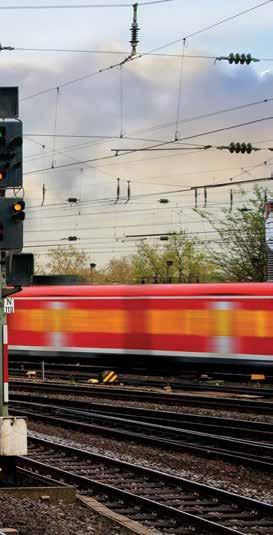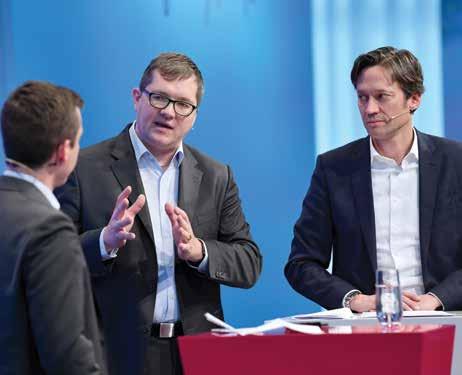
5 minute read
Siemens Mobility on capital, operational savings through smart maintenance
from REX Sep 2019
by Prime Group
Siemens striving for 100 per cent availability
Siemens Mobility Head of Data Services, Gerhard Kress, tells Rail Express about the transport technology firm’s push for a world with zero unscheduled railway outages.
IF YOU’VE REGULARLY CAUGHT THE train in a major Australian city, the prospect of a passenger rail service with zero unscheduled downtime seems too good to be true.
Fortunately for Gerhard Kress, Siemens Mobility’s Head of Data Services, the idea is not so difficult to comprehend.
“If you combine very good maintenance processes with a proper use of data, you can actually get to very high availabilities,” Kress tells Rail Express on the sidelines of Digitalize 2019 in Brisbane. “Across the globe at the moment we have 17 or 18 projects where we achieve from 99.92 to 99.98 per cent availability. “One flagship is the high-speed connection in Russia, from Moscow to St Petersburg, where the last technically-induced delay was in February 2018; 10 million kilometres without an unscheduled outage.
“To achieve this, you need to have some solid underlying processes.”
Siemens Mobility’s solution to provide such “solid underlying processes” is Railigent.
Siemens says Railigent is designed to make the best use of data to guide rail operators towards 100 per cent availability. Powered by the company’s open Internet of Things (IoT) operating system, MindSphere, Railigent applies artificial intelligence and sophisticated analytics to large volumes of rail data collected by IoT devices in the field.
Kress calls it “predictive monitoring”, and it has major maintenance applications across fixed infrastructure and rollingstock.
Turning maintenance depots into pit stops Kress says the focus for Siemens in developing the Railigent solution has been to help operators achieve lean but robust maintenance processes, through the support of very efficient documentation. “You have to make sure that every time a train comes into the depot, you can continue right away with your maintenance program where you left off,” Kress says.
Along with scheduled maintenance regime, the predictive monitoring technology allows for corrective maintenance to be scheduled on a train before something goes wrong.
In the example of Siemens’ Thameslink operations in the United Kingdom, 40 per cent of all corrective maintenance tickets are created automatically by the Railigent system, while the other 60 per cent come from data fed from the system to the maintenance desk, where it is assessed so appropriate work orders can be created while the train is still on the tracks. All of this is compiled into instructions for maintenance teams well ahead of a train’s arrival at a depot. This way those teams can be ready with the right parts and tools in the right places, so when one of Thameslink’s 8- to 12-car trains come into the depot, work can begin on the right sections ABOVE: Having near zero unscheduled downtime on train services is possible with Railigent.

of the train, right away.
“If your team is in the wrong place, or if you’re missing something during this process, going into the store to get the right part or tool might take you an hour of wasted time, which might be a significant part of your maintenance window for that train,” Kress says.
“With the right systems you can reliably know what work can be done in that time, and you are able to better prioritise certain work as you need to.”
The other element of this process is performed by an API interface between Railigent and an ERP system to track the operator’s spare parts and components.
“As an example, when Railigent detects something wrong with a bogie, the right parts are automatically ordered and ready, so you can simply remove the bogie that needs maintenance when the train comes in, and put a fresh one in its place,” Kress explains. “Then you can perform the work on the bogie separately. But what’s important is you can keep track of where that bogie was, and the mileage of that bogie, because as part of your preventative maintenance schedule you want to ensure that bogie has its scheduled overhauls once it reaches distance milestones, wherever that mileage came from.”
Another benefit of this robust solution comes when new parts are required from the local supply chain. Siemens guarantees, for its European customers, the 24-hour supply of replacement parts all across the continent – a measure which has allowed several smaller operators to eliminate much of their stock of parts and components. “For operators that are newly created, perhaps with smaller fleets of rollingstock,” Kress continues. “Why should they invest in big depots full of spare parts?”
Fleet efficiencies The benefits of achieving zero unscheduled outages go beyond just operational improvements. As Kress explains, less downtime means you can make a significant saving on your capital expenditure as well. “When you look at many fleet procurements today in rail, they’re actually procuring 15 per cent excess capacity, on average, just as a backup,” he says.
“That’s something you can easily spare, especially when you have some cities where you’re already running at such short headways that you can’t get more trains in.” Extra capacity is still needed in light rail and streetcar environments, where unexpected and unavoidable collisions with road vehicles are an unfortunate inevitability. Networks which deal with extreme weather also need some extra fleet capacity to deal with unexpected externalities.
But for the rest of the rail sector, Kress says smart maintenance regimes employing modern predictive monitoring systems can limit excess fleet expenditure to an absolute minimum. “The question is,” Kress continues, “is acquiring excess capacity the best way of using your money, or is it better to use the money by simply procuring the right number of assets, and then ensuring they don’t breakdown unexpectedly?
“Additionally, with the right systems in place, when something happens – which it will occasionally – you can ensure you’re able to effectively contain the problem and avoid having it spread throughout the whole network. “This way you get a lot more value out ofyour spending.”
Independent of fleet Kress says Siemens made a point during the development of Railigent, that the solution be applicable – within reason – to any rollingstock, anywhere in the world. That means a monitoring system that is not designed just for one fleet, but for all. “An operator has a clear demand to manage their own fleet, or set of fleets,” he says. “If every customer tries to integrate a solution on their own, that’s probably not as efficient as someone delivering that integration for them. So that’s why we’ve developed the system in an open way.
“This enables us to deliver a certain set of metrics that when integrated with partner and customer interfaces, can apply to any fleet,” Kress concludes.
BELOW: Kress (middle) says less downtime with a good system means you can make good savings on capital expenditure too.










